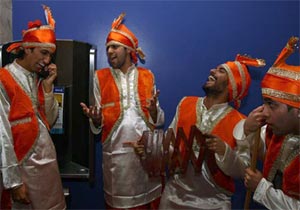 |
| Sagar Jha, Manav Malhotra, Pal Randhawa and Shiva Kale are members of a dance group which performs traditional Punjab Bhangra. (Bruce Bottomley Photo) |
Chak de—“giving it your all”—is the theme for this year’s Indian Subcontinent Student Association (INDISA) night. And what a great premise for an event that promises to be one of the biggest INDISA nights ever.
“We plan to have a classical Bengali dance, a Bollywood-style show and, of course, our huge fashion show,” says Pal Randhawa, who with Manjari Singh, has been helping coordinate this year’s INDISA night.
“This year we want to incorporate and celebrate the many different cultures and traditions all over South Asia,” says Ms. Singh, a second-year commerce student.
Mr. Randhawa is also a member of a six-men troupe that will be performing a traditional Punjab dance called Bhangra during INDISA night.
“INDISA night is one of the biggest events that the Indian, Pakistani, Sri Lankan, Bengali and Nepal community has here in Halifax and many of us have been involved in these performances since we were kids,” says Mr. Randhawa, a third-year microbiology and IDS student .
Bhangra is a traditional folkdance originated in Northern India in the Punjab region. The dance itself can be traced as far back as 300 BC and has evolved and adapted to the cultural influences and societies over time. It is performed at many celebrations such as weddings, New Year’s and the coming of the harvest.
“Its popularity is spreading as it’s becoming more popular and fusing with other types of modern music like hip hop and dance music,” he says.
The troupe started off with just three performers and has grown to include six men altogether: Shivum Kale, Sagar Jha, Manav Malhotra, Raju Abhi, Neil Grewal and Pal Randhawa. All the guys come from different religious and cultural backgrounds but are all tied together by the Bhangara dance.
“We’ve been performing bhangra since we were kids, says Randhawa. “It’s just a fun and energetic dance that anyone can pick up.”
The traditional costume for a bhangra for men is composed of several vibrant and richly coloured garments. The pag, or turban, is considered a sign of pride or honour in Punjab and is worn with a turla or fan like adornment on their head. The kurta, is a loosely worn garment similar to a silk shirt that is sometimes embroidered and is worn with a jugi or waistcoat. The vibrant costumes enhance the dancers’ performance.
In addition, there will be several other performers at INDISA from regions such as Mumbai, Pakistan, Sri Lanka and Southern India.
INDISA night is scheduled to take place Saturday, March 7, starting at 6:30 pm. In the McInnis Room, Dal SUB. Tickets are $18 for students and $20 for general admission and can be bought at the International Student & Exchange Services office.
